This post may contain affiliate links. Please see our disclosure policy.
Homemade pickling spices are one of those pantry staples that are surprisingly simple to make—and endlessly customizable. This blend is adapted from the Ball Complete Book of Home Preserving and includes all the classic spices you’ll need for everything from sour dills to sweet relishes.
You can stick with the traditional mix or add extras like celery seed, caraway, or juniper to suit your taste.
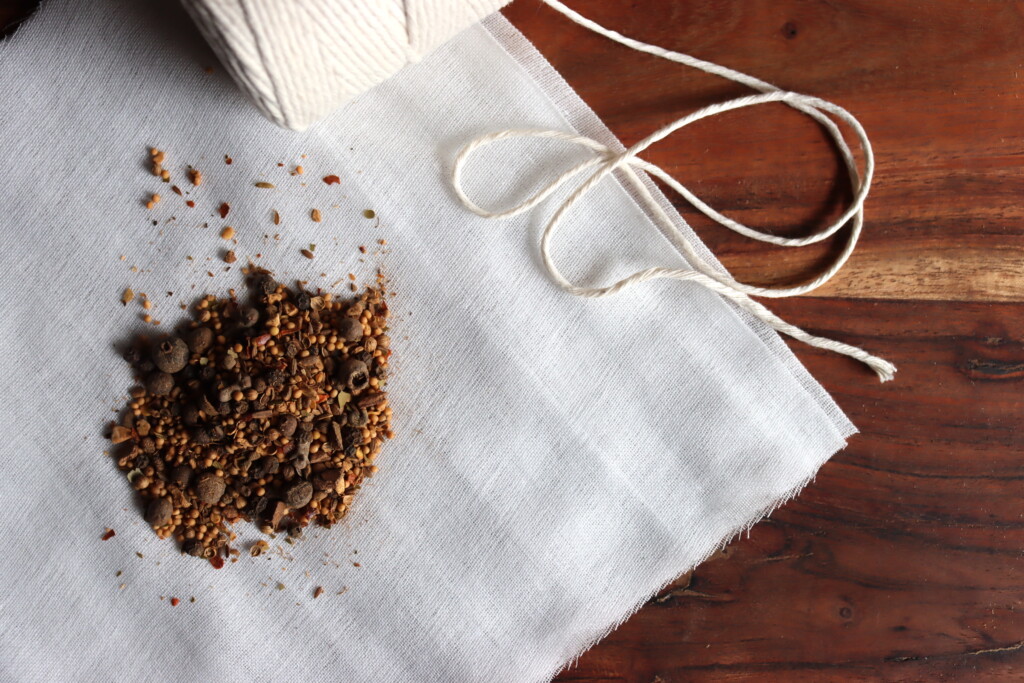
Table of Contents
There are a lot of different versions of “pickling spices” out there, and you’ll find plenty of regional variations depending on where you shop. Even at my local food co-op, there are three different bulk pickling spice blends from Frontier alone—basic, sweet, and hot & spicy—and each one has its own spin. Some lean heavily on warm spices like cinnamon and allspice, while others include celery seed and caraway for a more Eastern European flavor.
This homemade version is adapted from the Ball Complete Book of Home Preserving, which makes it a great fit for most canning recipes. Since Ball pickling spice is the one most often assumed in tested pickling recipes, it’s a safe bet flavor-wise. It’s very similar to the blend from Frontier Organic Spices, minus the celery seed and caraway—though you can always toss in a bit of each if you prefer.
The version from Food in Jars is nearly identical too, with the only notable swap being juniper berries instead of red pepper flakes. That just goes to show how much room there is for personalizing your spice mix.
This recipe makes about a half-pint jar, which is plenty to get through a summer of pickling (unless you go crazy with pickles each year like we do, in which cas you can double, triple or quadruple the batch). Whether you’re doing vinegar pickles, fermented brines, or old-fashioned relishes, this mix will give you a good, balanced flavor that works across the board.
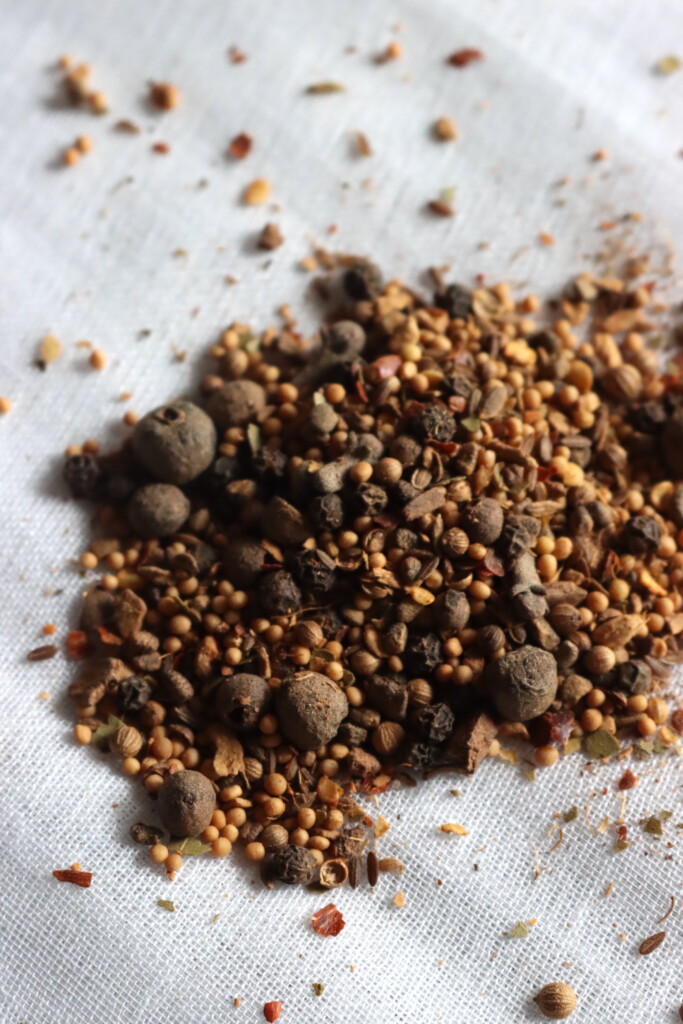
Why Make Your Own?
There are a few good reasons to skip the store-bought mix:
- Freshness – You control when it’s made, so it’s more fragrant and potent.
- Customization – You can dial up or tone down the heat, skip spices you don’t love, or add in extras like celery seed or juniper berries.
- Cost Savings – Especially if you already buy spices in bulk or have a well-stocked pantry.
- Canning Confidence – You’ll know exactly what’s going into each jar, with no mystery fillers or salt added.
The main reason here is freshness. When you buy a spice mix at the store, odds are it’s been sitting there for a LONG TIME. Pickling spices don’t tend to be fast movers on grocery store shelves, and they’ll sit there a lot longer than individual spices. When you buy individual spices, they’re almost always fresher and more fragrant than the store bought stuff.
If you are buying pickling spices, it’s much better to buy them online directly from the manufacturer. Before we started making our own, my go to was the Organic Pickling Spices from Frontier. You get get a whole pound of them for the same price you’d pay for an ounce or two at the grocery store, and they’re much fresher.
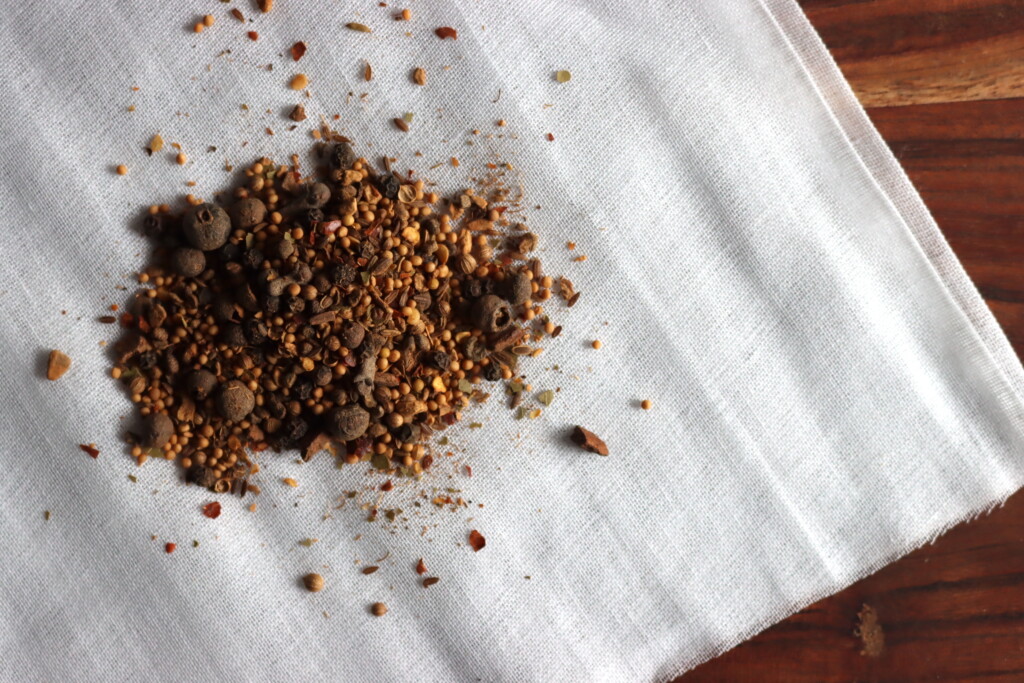
Ingredients for Pickling Spices
This homemade pickling spice blend includes the essential whole spices commonly used in traditional vinegar pickles and relishes. It’s adapted from the Ball Complete Book of Home Preserving, making it a reliable match for most tested canning recipes that call for “pickling spice.”
Here’s what goes into the base blend:
- Cinnamon Sticks – Adds warmth and subtle sweetness to the brine.
- Bay Leaves – Earthy and aromatic, they create a deep background flavor.
- Mustard Seeds – A foundational pickling spice that brings tang and mild heat.
- Allspice – Sweet and slightly peppery, with a hint of clove.
- Coriander Seeds – Bright and citrusy, they balance out the richer spices.
- Black Peppercorns – Add classic pungency and bite.
- Ground Ginger – Offers gentle spice and complexity.
- Dill Seeds – Essential in cucumber pickles, and a great addition to any vegetable brine.
- Cardamom Seeds – Floral and slightly sweet, especially nice in sweet or mixed pickles.
- Hot Red Pepper Flakes – For heat and depth; can be increased for spicier blends.
- Whole Cloves – Aromatic and warming, they give the mix its signature spiced character.
Optional Additions
If you want to tweak the flavor or replicate a regional style, these optional spices are commonly found in other traditional blends:
- Celery Seed – Adds a savory, slightly bitter herbal flavor—great in bread and butter pickles.
- Caraway Seed – Brings a distinct, slightly anise-like note typical of Eastern European preserves.
- Brown Mustard Seeds – Stronger and more pungent than yellow mustard, often used in spicy blends.
- Chipotle or Dried Chili Pieces – Add smoky heat and depth.
- Mace or Nutmeg Slivers – Sweet, warming spices found in older or sweeter pickle recipes.
- Juniper Berries – Piney and resinous, a unique addition to cucumber or mixed veg pickles.
- Ginger Chips or Dried Ginger Flakes – If available, these give a clean flavor without clouding the brine.
This blend is flexible—stick with the basics or add your own twist depending on the style of pickles you’re aiming for.
Store Bought Pickling Spices
If you’re purchasing a pickling spice blend, here’s what’s in the common blends from Frontier Spices:
Basic Pickling Spices: Yellow Mustard, Cinnamon, Allspice, Dill Seed, Celery Seed, Bay Leaf, Chili Peppers, Cloves, Caraway, Ginger.
Mild Sweet Pickling Spices: Yellow Mustard, Cinnamon, Allspice, Dill Seed, Celery Seed, Bay Leaf, Chili Peppers, Cloves, Caraway, Ginger.
Hot and Spicy Pickling Spices: Cinnamon Chips, Yellow Mustard, Dill Seed, Brown Mustard, Allspice, Cloves, Coriander Seed, Chipotle Peppers, Mace, Black Peppercorns, Bay Leaf, Cardamom, Ginger Root.
Ball Canning also makes small vials of pickling spices, and they include: Mustard Seed, Black Peppercorns, Dill Seed, Cardamom, Cinnamon, Ginger, Coriander, Allspice, Chili Pepper, Cloves and Bay Leaves. Or, more or less what’s in this pickling spices recipe.
They sell it in small containers though, and it’s kinda expensive at around $8 per ounce (or roughly 10x as much as the bulk pack from frontier with very similar spices.
I don’t recommend the generic blend from McCormick because they’re often not fresh, and it includes preservatives (sulfites). Though they do include the same ingredients as the mix from Ball Canning.
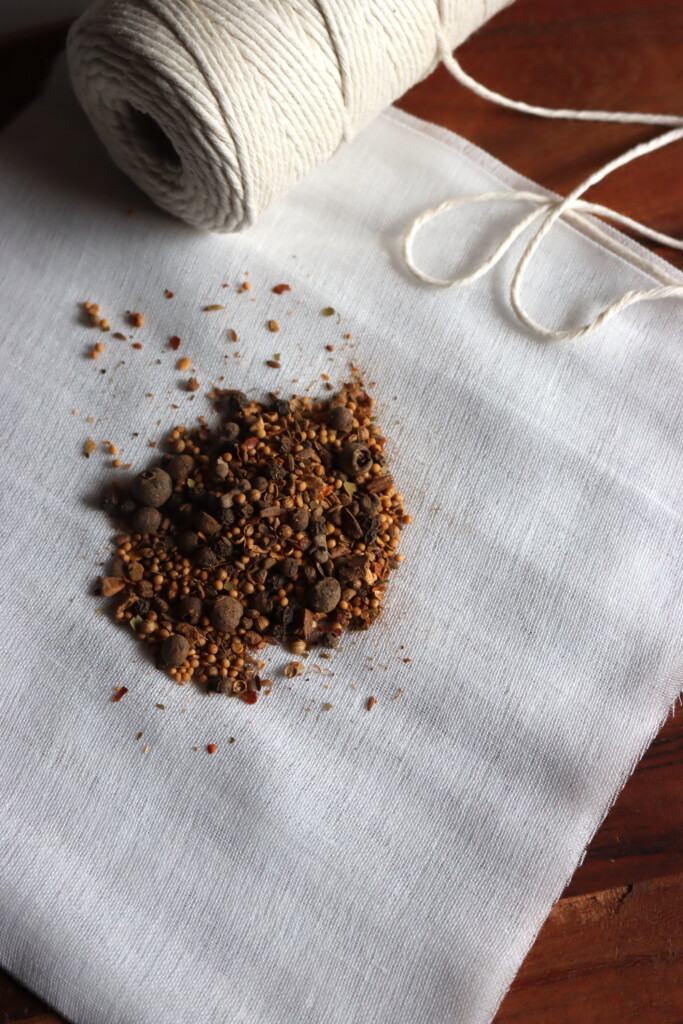
Using Pickling Spices
This blend works well for both vinegar brine and fermented pickles. Most recipes will have you use a spice bag, or a small square of cheesecloth tied into a pouch. The pouch steeps in the brine or pickling liquid, infusing the flavor without scattering whole spices throughout the jar.
That said, some recipes call for adding spices directly to the jars, especially for shelf-stable vinegar pickles. In that case, whole spices work best—they sink to the bottom and add flavor without clouding the brine or making the pickles gritty.
Just check the instructions in your recipe to know how to use them.
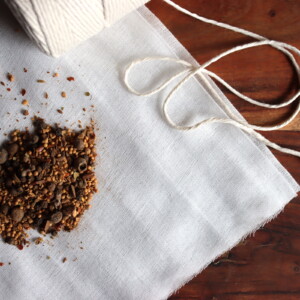
Pickling Spices
Ingredients
- 2 medium cinnamon sticks, 4-inch, broken into small pieces
- 10 medium bay leaves, crushed
- 4 Tbsp mustard seeds
- 2 Tbsp whole allspice
- 2 Tbsp coriander seeds
- 2 Tbsp whole black peppercorns
- 2 Tbsp ground ginger
- 2 Tbsp dill seeds
- 1 Tbsp cardamom seeds
- 2 tsp hot red pepper flakes, adjust to taste
- 2 tsp whole cloves
Instructions
- In a clean bowl or directly in a glass jar, combine all the spices.
- Stir thoroughly to evenly distribute the ingredients.
- Transfer to a half-pint (8 oz) jar and seal tightly with a lid.
- Store in a cool, dark place for up to 12 months.
Notes
Spice Bag Tip: For most pickling recipes, use 1 to 2 tablespoons of the mix in a small cheesecloth bag or spice ball per quart of brine. Remove after simmering or before sealing jars.
Flavor Variations: Add 1 teaspoon each of celery seed and caraway seed for an Eastern European flavor twist. You can also experiment with juniper berries (used in some versions like Food in Jars).
Sweet vs. Spicy: For a milder blend, reduce or omit the red pepper flakes. For more heat, double them or toss in a few dried chili peppers or even a pinch of chipotle.
Nutrition
Nutrition information is automatically calculated, so should only be used as an approximation.

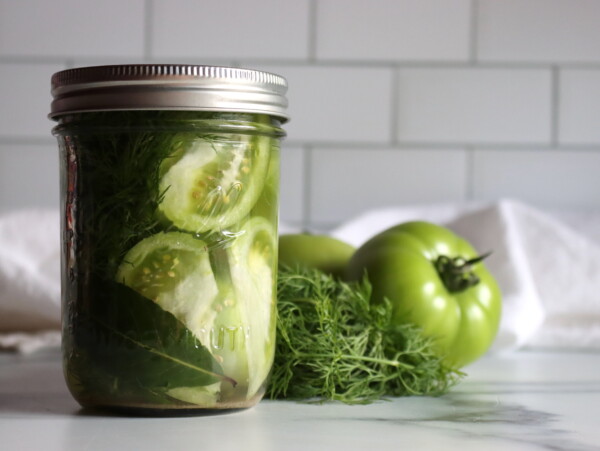
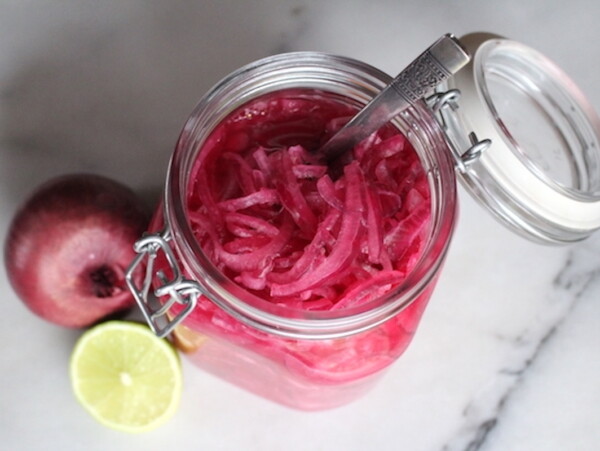

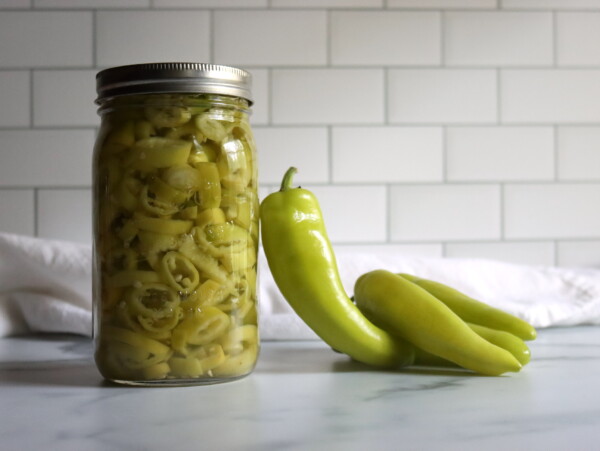
Thank you for the tongue pickle recipe
As a kid my aunt in Vermont would every season make these and I did as a young adult
I stopped canning and gardening now in my later years thinking of those pickles. I could not find my recipe I’m so glad you posted this recipe
Patricia
Yeah, this one’s a fun piece of Vermont history for sure! So glad you enjoyed them =)